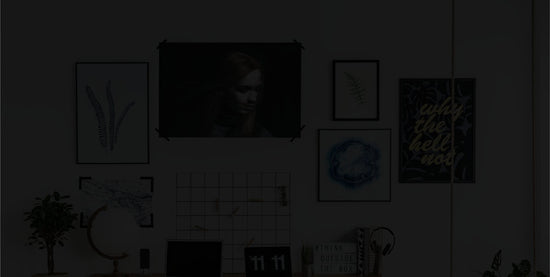Are you thinking of using monochromatic art for your wall decor but afraid it will look boring? Perhaps you have a piece or two ready to be hung, but you’re just not sure how to style it on your wall.
Monochrome art is a subtle style of art that is great for featuring in your space, but it’s easy to think that it limits your style and that there’s not much you can do with it. However, you’d be surprised how many ways you can decorate with it, as you will soon see in this article.

There’s more to monochromatic art than meets the eye (Hint: It’s not just about having only one color!) and there are multiple ways to style it in a room. You’ll also get some tips on how to hang it up on your wall.
Ready? Let’s dive in!
What is monochrome art?
Monochrome art is artwork that features only one color, typically black or white. It was linked to minimalism and abstract art in the 1900s and is popular today as a style that represents purity and simplicity through its subject matter.
Monochrome art comes in many types of mediums, from paintings and drawings to prints and photographs. In interior design, monochrome palettes have enjoyed a boom in popularity as recently as 2021.
While it often uses just one color, a lot of monochrome art derives a variety of shades and tints from the same hue or color. So while you’ll usually see a black or white piece, there are also many works that utilize a color’s spectrum from lighter to darker renderings.

For instance, if you had an artwork that uses a black base, it might show details toned with gray. Or if a piece was in monochromatic red, it might be accompanied by tints of pink.
Although art in this style limits the palette it uses, it’s able to highlight other details of a piece such as its lines, form, texture, space, and proportion. Displayed in a room, this helps to build an atmosphere and add character.
As an understated art style, how can you decorate your home or workspace with monochrome art? Get started with these ideas!
Monochromatic Art Decor Ideas
1. As a statement piece
Monochrome art draws focus to its subject matter and commands attention because of its variations in form and texture that resonate with people. This makes it a great focal point for your space. Its restriction to a certain hue allows it to shine as a statement piece instead of fading into the background.

Consider size—a large canvas piece would create the illusion of a bigger space and stand out nicely in the living or dining room, but a smaller piece like a clay sculpture would also make a splash in the middle of a conference or coffee table.
2. Multiple artworks in one color
Imagine a whole art wall in one specific color. Now maybe that sounds a little boring to you. But take several artworks that each use a different shade or tint of one color and you have a charming gallery of pieces in visual harmony with each other.

Take blue—you can put together pieces that are colored navy blue, sky blue, cerulean, light turquoise, etc. You can do this with any color or hue, and you don’t have to limit yourself to wall art. Experiment by incorporating art objects like sculptures, ceramics, and glass art.
3. Play with textures
Even if you employ multiple shades of one color, there’s still the risk of your display becoming monotonous. You can prevent that by focusing on other aspects of the artwork outside color. As we mentioned earlier in the article, monochrome art is great for showcasing various aspects of an art piece that are easily overlooked, like texture.

Mix it up with your mediums to make your picture hanging collection more interesting. Frame drawings alongside paintings, and hang up personal photographs together with your favorite posters and prints. By showcasing different forms of monochrome art, your guests will be able to appreciate the variety that the art style offers while you stay true to what speaks to you.
4. Mix and match artworks salon-style

The salon hanging style has been popular since the 17th century and was commonly used as an exhibition display style in museums and art galleries. It’s still in fashion today, especially among homeowners and designers, and it’s noted for the way it styles artworks densely.
This picture hanging style typically uses metal or wooden hooks to hold picture hanging wire and is supported by heavyweight picture rails that allow multiple frames to be moved freely. Hang up different-sized pieces side by side or exhibit artworks from several different artists to build your own monochrome salon wall.
5. Accentuate with lighting
While there are several ways to accentuate your monochrome art decor, lighting is one of those that make a display of art look more dynamic. This is particularly relevant in this case since we’re working with monochrome pieces. You can use lighting fixtures already installed in your home or ceiling-mounted lights, or explore other options like wall washers and track lighting.

Lighting is an important part of displaying art, so many of the examples we’ve listed are also the choices of art galleries. Be sure to consider minimalistic designs so they match seamlessly with your monochrome selection no matter the art style or medium.
6. Build your room’s color palette around it
Once you’ve started embracing monochrome art, you might also be open to setting up the rest of your room in the same color as those featured in the artwork. This is something that’s a bit more out there, so think of it as going all-in after starting small with wall art or art objects.

It’s ideal to work with a color that you actually love so you enjoy the process and the results. Create depth by applying the principle behind idea number 2 in this article—consider furniture in darker shades, carpets and rugs in mellow tints, and even matching walls. Dedicating your whole space to your monochrome art’s palette will make it feel like it’s an extension of the artwork, creating a vibrant, sophisticated look.
How to hang monochrome art on your wall
Here are a few tips for displaying monochrome art as wall-mounted pieces:
1. Mind the frame
Some artworks work fine frameless, but if you’d prefer to frame them up, it’s good to look for a frame that complements the art and the rest of your space.

You don’t want to take away from the piece, so a black or white frame is a safe bet to start with. You can choose from a variety of patterns, sizes, and finishes, and even mix and match the frames with the artworks depending on your hanging style.
2. Eye-level placement is key
It’s a good rule of thumb to place wall art within your line of sight upon entering a room. This is how you direct a guest’s attention to a statement piece or gallery wall.

3. Utilize picture hanging tools
When hanging up your precious artwork, it’s crucial to use the right tools and materials. If you were putting up a small canvas painting, for instance, you wouldn’t want to go straight for French cleats as there are better suited picture hanging tools for canvas and other lightweight pieces.

Our sawtooth hangers provide a seamless way to mount heavy duty artwork.
French cleats are a great choice for mounting heavier frames and larger canvases. But for lighter or medium-sized artwork, sawtooth hangers and D-rings are some good options to look at. For art pieces that decorate your table or shelves, an acrylic easel is a nice touch and secures artwork that isn’t bolted to your wall.
Final Thoughts
Rather than thinking of monochrome art as something dull or monotonous, think of it as a challenge to create balance and an art wall that doesn’t fall flat. With the ideas in this article, you’re now ready to take on that challenge.
As long as you enjoy the process and trust your creative intuition, you’ll have a captivating display of art in your home or space! But if you need more help with getting started or questions about how to put up your artwork, you’re welcome to mail us or leave a comment!













Leave a comment (all fields required)